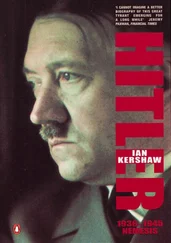24. DZW , 6, pp. 549–50; Sönke Neitzel, Abgehört: Deutsche Generäle in britischer Kriegsgefangenschaft 1942–1945 , Berlin, 2005, p. 190, 9.3.45 (Eng. edn., Tapping Hitler’s Generals: Transcripts of Secret Conversations, 1942–45 , Barnsley, 2007, pp. 141–2).
25. BAB, NS6/135, fos. 79, 97, Erfahrungs- und Stimmungsberichte über die Haltung von Wehrmacht und Bevölkerung, 23.3.45, 29.3.45.
26. BfZ, Sammlung Sterz, O’Wm. Peter B., 9.3.45.
27. Henke, p. 806 and n. 132.
28. BAB, R55/601, fos. 295–7, Tätigkeitsbericht, weekly propaganda reports, 21.3.45.
29. BAB, NS6/169, fos. 4–9, Bericht des Hauptgemeinschaftsleiters Twittenhoff über den Sondereinsatz der Partei-Kanzlei in Hessen-Nassau, for period 24–30.3.45. The consequence of providing a realistic description was the recommendation that Twittenhoff was not suitable for further work in the ‘Special Action’ of the Party Chancellery.
30. BAB, NS6/169, fo. 49, Vorlage an Reichsleiter Bormann, 19.3.45; fo. 51, Sprenger to Bormann, 14.3.45.
31. DZW , 6, pp. 550–51; 1945: Das Jahr der endgültigen Niederlage der faschistischen Wehrmacht. Dokumente , ed. Gerhard Förster and Richard Lakowski, Berlin, 1975, pp. 212–14, Staff of Army Group G to Gauleiter Gustav Simon about signs of a hostile attitude towards German troops and flight, in drunken condition, of the Volkssturm at the attack of the Americans on Trier. For further examples of a negative stance of the civilian population towards the Wehrmacht—even one case, in Göttingen, when civilians were said to have fired on their own tanks—see John Zimmermann, Pflicht zum Untergang: Die deutsche Kriegführung im Westen des Reiches 1944/45 , Paderborn, 2009, p. 75.
32. BAB, NS6/51, fos. 1–3, Letter from Hauptmann Heinz Thieme, Pzjäger Abt. 246, SD agent, Abt. Ostland, to Bormann, 15.3.45.
33. Marlis Steinert, Hitlers Krieg und die Deutschen , Düsseldorf and Vienna, 1970, p. 559; Neitzel, Abgehört , p. 190 (9.3.45) (Eng. edn., Tapping Hitler’s Generals , p. 141). See also Saul K. Padover, Psychologist in Germany: The Story of an American Intelligence Officer , London, 1946, pp. 219, 230, 270, for his experiences of defeatist attitudes and Germans welcoming the arrival of the Americans.
34. See John Zimmermann, ‘Die Kämpfe gegen die Westalliierten 1945—ein Kampf bis zum Ende oder die Kreierung einer Legende?’ in Jörg Hillmann and John Zimmermann (eds.), Kriegsende 1945 in Deutschland , Munich, 2002, pp. 130–31.
35. TBJG , II/15, p. 406 (3.3.45).
36. Katharina Elliger, Und tief in der Seele das Ferne: Die Geschichte einer Vertreibung aus Schlesien , Reinbek bei Hamburg, 2006, p. 107.
37. Workers in Berlin were reported in March as saying that no punishment was severe enough for the cowardice of deserters.— Das letzte halbe Jahr , p. 277 (3.3.45).
38. IfZ, Fa-91/2, fos. 330–31, Parteikanzlei, Vermerk für Pg. Walkenhorst, 10.3.45. For Hanke’s brutal rule in Breslau in the last months of the war, see Guido Knopp, Der Sturm: Kriegsende im Osten , pb. edn., Berlin, 2006, pp. 150–62.
39. DZW , 6, p. 548, for Rundstedt’s order. For Kesselring’s advocacy, after taking command in the west, of ruthlessness towards deserters and those seen to be failing in their duty, see Andreas Kunz, Wehrmacht und Niederlage: Die bewaffnete Macht in der Endphase der nationalsozialistischen Herrschaft 1944 bis 1945 , Munich, 2007, pp. 276, 279. Hitler’s order to establish the ‘flying court martial’ is printed in Rolf-Dieter Müller and Gerd R. Ueberschär, Kriegsende 1945: Die Zerstörung des Deutschen Reiches , Frankfurt am Main, 1994, pp. 163–4; see also Neitzel, Abgehört , pp. 202–3, 540 n. 161 (Eng. edn., Tapping Hitler’s Generals , pp. 150–51). Hübner, a fanatic who had long been involved in attempts to instil Nazi ideology into the troops, was given unrestricted powers to impose the death penalty.— DRZW , 9/1 (Förster), pp. 580–82; Manfred Messerschmidt, Die Wehrmachtjustiz 1933–1945 , Paderborn, 2005, p. 413. Flying courts martial had been in use by Army Group North since 3 February.—BAB, NS6/354, fo. 88, RS 123/45g, Maßnahmen zur Stärkung der Front durch Erfassung Versprengter (passing on to the Gauleiter an order of the Commander-in-Chief Army Group North, Colonel-General Lothar Rendulic´), 9.3.45.
40. 1945: Das Jahr der endgültigen Niederlage der faschistischen Wehrmacht , pp. 229–30.
41. Henke, p. 348.
42. DZW , 6, p. 548.
43. DZW , 6, p. 522; Stettin/Szczecin 1945–1946 , Rostock, 1994, pp. 35, 37.
44. BAB, NS6/354, fos. 163–165 v, PK Bekanntgabe 149/45g, 19.3.45, transmission by Bormann of Schörner’s secret circular of 27 February.
45. DZW , 6, p. 539.
46. Zimmermann, Pflicht , p. 338; Christopher Clark, ‘Johannes Blaskowitz—der christliche General’, in Ronald Smelser and Enrico Syring (eds.), Die Militärelite des Dritten Reiches , Berlin, 1995, pp. 35, 43.
47. DZW , 6, p. 545.
48. Quoted in DRZW , 10/1 (Zimmermann), p. 316; and Zimmermann, Pflicht , p. 293.
49. BAB, R3/1623a, fo. 71a, Bormann to the Gauleiter, Reichsleiter, Reich Youth Leader, etc., 30.3.45, passing on Jodl’s circular of the previous day to commanders of the Army Groups and the Defence Districts in the west. Jodl still believed that any sacrifice was worthwhile to win time and bring about a split in the unnatural enemy coalition.—Bodo Scheurig, Alfred Jodl: Gehorsam und Verhängnis , Berlin and Frankfurt am Main, 1991, pp. 313–14, 319.
50. For the unprompted initiatives of the generals in the last phase to ensure the continued, utmost military effort, see DRZW , 10/1 (Zimmermann), pp. 307–36.
51. BAB, NS6/134, fo. 19, Dönitz, Kurzlagebericht vom 4.3.45.
52. DRZW , 9/1 (Förster), pp. 554, 584–6. See, for Dönitz’s fanatical leadership of the navy, Sönke Neitzel, ‘Der Bedeutungswandel der Kriegsmarine im Zweiten Weltkrieg’, in Rolf-Dieter Müller and Hans-Erich Volkmann (eds.), Die Wehrmacht: Mythos und Realität , Munich, 1999, pp. 259–62.
53. Kathrin Orth, ‘Kampfmoral und Einsatzbereitschaft in der Kriegsmarine 1945’, in Hillmann and Zimmermann, pp. 137–55.
54. BA/MA, N574/22, NL Vietinghoff, ‘Die Generale’, 25.7.49.
55. BA/MA, N574/19, NL Vietinghoff, ‘Kriegsende in Italien’, fos. 44–5 (1950). See also DRZW , 10/1 (Zimmermann), p. 321; and Zimmermann, Pflicht , pp. 297–8.
56. Neitzel, Abgehört , pp. 180–81, 185 (quotation, p. 186) (28–31.1.45, 18–20.2.45) (Eng. edn., Tapping Hitler’s Generals , p. 138). Also NAL, WO208/4365, reports of monitored conversations of prisoners of war, nos. 251–3, 28–31.1.45. A former corps commander, a lieutenant-general, later told his British captors that Rundstedt had favoured capitulation after the failure of the Ardennes offensive, and reckoned with the support of a majority of the higher ranking members of the officer’ corps, but knew that the hold of the Nazi regime meant that there was no chance of undertaking negotiations and that no member of the Wehrmacht would be authorized to contact the Allies for such a purpose.—LHC, Dempsey Papers, no. 317 pt. II, p. 5, (16.4.45).
57. Neitzel, Abgehört , pp. 184–5, 187 (14–15.2.45, 2–3.3.45) (Eng. edn., Tapping Hitler’s Generals , pp. 137, 139).
58. NAL, WO208/5543, interrogation reports on German prisoners of war, 16.4.45, ‘Enemy Expectations, Intentions and Sources of Information’, 16.3.45.
Читать дальше












